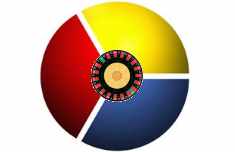The Law of The Third Betting System. We Explain…..
 This betting system comes from the field of statistics and in particular a topic known as The Law of The Third.
This betting system comes from the field of statistics and in particular a topic known as The Law of The Third.
Let´s take a roulette wheel as an example, and see how the distribution of numbers that you would get over time follows the Law of The Third pattern.
So say we are sitting pretty in Las Vegas in front of a European roulette wheel with 37 wells in total. I know we are in Las Vegas so maybe we should be playing American Roulette, but the odds are better on European roulette so always play this version. If you can´t find a European wheel, get on a plane immediately to Monaco!
The wheel should have 18 black wells, 18 red wells and a green 0 well. So the odds of you winning a single number bets 1:37, : roughly 3%.
Now if you sit back and watch how the numbers fall in over time, you might start seeing some interesting patterns. You are very unlikely to see all 37 numbers (including the zero) come up in 37 spins. Some numbers will repeat. The Law of the Third predicts that, looking at an average distribution curve, after you have observed the wheel for 37 spins, you are likely to have seen 24 or so numbers come up (two thirds of the wheel in other words). A third of the wheel will remain dormant (we are talking averages here- you might see all 37 numbers).
The Law of The Third betting system tries to use this information to create an advantage. The bets on a roulette table are nicely split into thirds anyway: you have got your column bets on groups of dozen numbers (all 12 numbers on a verticle line) and your 1st 12, 2nd 12, 3rd 12 (Dozen Bets). Track and bet on either the dozens or the columns (or switch around half way through if you want). If one number comes up twice in a session in one column or dozen, place a wager on the other 2.
If 2 numbers come up in different columns (or dozens) for the first time, place a wager on the same columns or dozens looking for a repeat. So- what´s the synopsis on this system?
Well, at the outset, it all seems very sensible in that you get alot of “bell shaped curves” in statistics, meaning that the distribution isn´t normally evenly spread. Some numbers will come up more than others in a 37 spin scenario. The problem with this theory, however, is that it is what we call a “memory system”, in that it is making an assumption that historical results somehow have an impact on future results. This may be true in some situations like a statement such as “am I more likely to slip up if it has snowed”.
However, on the roulette table, the roulette wheel has no memory. Each spin is a mutually exclusive event, and so what has just happened has no bearing on what might happen on the next spin. The Law of The Third is a prediction of 37 spins. Just remember that you are making a bet on a single spin when you bet at the roulette table.
Having said that, we often use systems to make sure that we play more rationally as it helps us to set stop-loss and profit taking targets. If you use it in this way,it can be useful. But it won´t alter the odds that you get on the table.